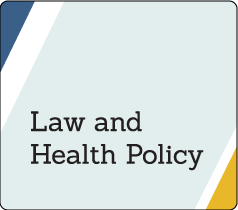This content was part of the Healthy People 2020 Law and Health Policy project, which ended in 2020.
Healthy People 2020 Law and Health Policy Project Webinar Summary
The Healthy People 2020 Law and Health Policy Project webinar held on May 26, 2020 — A Comprehensive Approach to Preventing Suicide: The Role of Law and Policy and the Social Determinants of Health — examined the impact of evidence-based law and policy approaches on suicide prevention. The webinar featured the following presentations:
Carter Blakey, Deputy Director, Office of Disease Prevention and Health Promotion (ODPHP), U.S. Department of Health and Human Services (HHS), provided an introduction to the Healthy People initiative and the Healthy People 2020 Law and Healthy Policy Project. She also described the role of evidence-based legal and policy approaches to help prevent suicide.
Alex Crosby, MD, MPH, Chief Medical Officer, National Center for Injury Prevention and Control, Division of Injury Prevention, Centers for Disease Control and Prevention (CDC), discussed strategies within CDC’s Suicide Prevention Technical Package.
Sarah Brummett, MA, JD, Director, Office of Suicide Prevention, Colorado Department of Public Health and Environment, described the Colorado-National Collaborative for Suicide Prevention and the work they do to identify, promote, and implement strategies for suicide prevention in Colorado.
Nicola Winkel, MPA, Project Director, Arizona Coalition for Military Families, gave an overview of the Collective Impact for Veteran Suicide Prevention project and their comprehensive suicide prevention efforts in the military and Veteran community.
Richard McKeon, PhD, MPH, Chief, Suicide Prevention Branch, Substance Abuse and Mental Health Services Administration (SAMHSA), shared updates on federal initiatives focused on suicide prevention.
About Healthy People and the Law and Health Policy Project—Carter Blakey, ODPHP
Healthy People is an HHS-led initiative aimed at improving population health and achieving health equity across the nation. For several decades, Healthy People has provided science-based national objectives and ambitious 10-year targets for improving the health of the nation. The initiative serves as a roadmap for health promotion and disease prevention efforts. Healthy People 2020 featured more than 1,200 objectives across 42 topic areas. It provided a framework for understanding where were, planning for where we needed to be, and learning how to get there over the following 10 years.
The Law and Health Policy Project was a collaboration between ODPHP, the Centers for Disease Control and Prevention (CDC), the CDC Foundation, and the Robert Wood Johnson Foundation (RWJF). It aimed to improve the health of communities by sharing information about evidence-based law and policy interventions. The project used the best data to describe the health objectives and issues being addressed, and it created reports examining the relationship between population health and law and policy interventions. Specifically, it explored how law and policy could be useful tools to improve health and reach the targets for specific Healthy People objectives.
Mental Health and Mental Disorders in Healthy People 2020—Carter Blakey, ODPHP
There were 12 main objectives in the Healthy People 2020 Mental Health and Mental Disorders (MHMD) topic area that focused on mental health status improvement, screening, and treatment expansion. Of these, there were 2 objectives specific to suicide prevention.
There was strong evidence that a comprehensive public health approach reduced suicide rates. Healthy People 2020 also included a social determinants of health framework that identified 5 key areas or determinants—economic stability, education, health and health care, neighborhood and built environment, and social and community context—that impacted health outcomes. The current situation with COVID-19 heightens many of the social determinants of health and risk factors identified for suicides, such as unemployment, the fear of poverty and housing evictions, lack of access to health and mental health services, food insecurity, and social isolation. While the impact of COVID-19 on suicide rates is unknown at this time, a greater understanding of comprehensive strategies that can create protective environments, promote connectedness, and reduce the impacts of these current societal challenges may also be beneficial.
In 2019, suicide was the tenth leading cause of death in the United States and the second leading cause of death for people age 10 to 34 years. About 1 suicide death took place every 11 minutes. Though suicide rates vary by race and ethnicity, certain populations, like Veterans and military personnel, are disproportionately impacted.
The Healthy People 2020 objective to reduce the suicide rate (MHMD-1) tracked suicide deaths throughout the past decade. In 2007, there were 11.3 suicide deaths per 100,000 people. The proposed Healthy People goal was to achieve a 10% reduction in the suicide rate by the year 2020 — however, the data available from 2017 indicated a 24% increase in suicides. State by state review of suicide rates revealed that only a few states were meeting or doing better than the national target.






